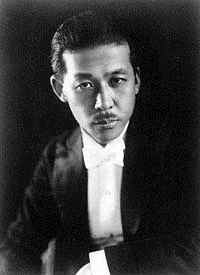Name Kosaku Yamada | Role Composer | |
 | ||
Died December 29, 1965, Tokyo, Japan Compositions KONOMICHI, KONOMICHI, Nagauta Symphony, Nagauta Symphony, National Anthem of Manchukuo, National Anthem of Manchukuo, Song of AIYAN: Song of AIYAN, Song of AIYAN: Song of AIYAN, A Flaming Sunset, A Flaming Sunset, Song of AIYAN: Caprice, Song of AIYAN: Caprice, Song of AIYAN: Higanbana (Amaryllises), Song of AIYAN: Higanbana (Amaryllises), Song of AIYAN: Rabbit-Ear Irides, Song of AIYAN: Rabbit-Ear Irides, Kono Michi, Kono Michi, Song of AIYAN: NOSKAI, Song of AIYAN: NOSKAI, Aka Tombo, Aka Tombo Similar People Hakushu Kitahara, Rofu Miki, Rentaro Taki | ||
Kosaku yamada symphony in f triumph and peace 1912
Kosaku Yamada (山田 耕筰, Yamada Kōsaku, 9 June 1886 – 29 December 1965) was a Japanese composer and conductor.
Contents
- Kosaku yamada symphony in f triumph and peace 1912
- Kuruka kuruka verr verr kosaku yamada
- Name
- Biography
- Major compositions
- Recordings
- References
Kuruka kuruka verr verr kosaku yamada
Name
In many Western reference books his name is given as Kôsçak Yamada. During his music study in the Imperial German capital of Berlin from 1910 to 1913 he hated the times when people laughed at him because his "normal" transliteration of his first name "Kosaku" sounded like the Italian "cosa" meaning "what" or "thing" + the German "Kuh" meaning "cow"; which resulted in his choosing a somewhat fanciful transliteration of Kôsçak Yamada ever since.
Biography
Yamada was born in Tokyo on 9 June 1886.
After studying at the Tokyo Music School, he left Japan for Germany where he enrolled in the Berlin Hochschule and learnt composition under Max Bruch and Karl Leopold Wolf and piano under Carl August Heymann-Rheineck, before returning to Japan. He travelled to the United States in 1918 for two years. During his stay in Manhattan, New York City he conducted the temporarily-organized orchestra, members of the New York Philharmonic and the New York Symphony, soon before their amalgamation.
Yamada left about 1,600 pieces of music. Especially, songs (Lieder) amount to 700 pieces of music excluding songs for schools, municipalities and companies. They were performed and recorded by many singers which include Kathleen Battle, Ernst Haefliger and Yoshikazu Mera. His opera Kurofune (The Black Ships) is regarded as one of the most famous Japanese operas.
As a conductor, Yamada made an effort to introduce many orchestral works to Japan. He was the first performer in Japan of Debussy's Prélude à l'après-midi d'un faune, Dvořák's Symphony No. 9, Gershwin's An American in Paris, Mosolov's Iron Foundry, Sibelius' Finlandia, Shostakovich's Symphony No. 1, Johann Strauss II's An der schönen blauen Donau, and Wagner's Siegfried Idyll.
Jacques Ibert's Ouverture de Fete was dedicated to the Japanese emperor and government for the 2,600th National Foundation Day in 1940 and premiered under the baton of Yamada.
Yamada died at his home in Tokyo of a heart attack on 29 December 1965.
